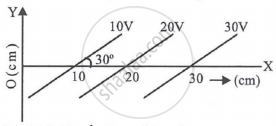Advertisements
Advertisements
Question
Equipotential surfaces ______.
- are closer in regions of large electric fields compared to regions of lower electric fields.
- will be more crowded near sharp edges of a conductor.
- will be more crowded near regions of large charge densities.
- will always be equally spaced.
Options
a, b and c
a, c and d
b, c and d
c and d
Solution
a, b and c
Explanation:
The density of the equipotential lines gives an idea about the magnitude of electric field. Higher the density, larger the field strength.
We know, the electric field intensity E and electric potential V are related as a, b and c
We know that on any two points of equipotential surface, potential difference is zero or of equal potential.
∵ `E = (-dV)/(dr)`
So the electric field intensity is inversely proportional to the separation between equipotential surfaces.
So equipotential surfaces are closer in regions of large electric. Thus, it verifies answer a
The electric field is larger near the sharp edge, due to larger charge density as a is very small
∵ `sigma = q/A`
So equipotential surfaces are closer or crowded. It verifies answer b.
As the electric field `E = (kq)/r^2` and potential or field decreases as size of the body increases or vice-versa (case of the earth), so the equipotential surfaces will be more crowded if the charge density `sigma = q/A` increases. It verifies the answer c.
As the equipotential surface depends on distance r by `E = (-dV)/r` and `V = (kq)/r`. Equipotential surface depends on charge density at that place which is different at a different place, so equipotential surface are not equispaced all over.
Hence the electric field intensity E is inversely proportional to the separation between equipotential surfaces. So, equipotential surfaces are closer in regions of large electric fields. As electric field intensities is large near sharp edges of charged conductor and near regions of large charge densities. Therefore, equipotential surfaces are closer at such places.
APPEARS IN
RELATED QUESTIONS
Describe schematically the equipotential surfaces corresponding to
(a) a constant electric field in the z-direction,
(b) a field that uniformly increases in magnitude but remains in a constant (say, z) direction,
(c) a single positive charge at the origin, and
(d) a uniform grid consisting of long equally spaced parallel charged wires in a plane.
What is the geometrical shape of equipotential surfaces due to a single isolated charge?
Draw the equipotential surfaces due to an electric dipole. Locate the points where the potential due to the dipole is zero.
Why is there no work done in moving a charge from one point to another on an equipotential surface?
A particle of mass 'm' having charge 'q' is held at rest in uniform electric field of intensity 'E'. When it is released, the kinetic energy attained by it after covering a distance 'y' will be ______.
Assertion: Electric field is discontinuous across the surface of a spherical charged shell.
Reason: Electric potential is continuous across the surface of a spherical charged shell.
Consider the following statements and select the correct statement(s).
- Electric field lines are always perpendicular to equipotential surface.
- No two equipotential surfaces can intersect each other.
- Electric field lines are in the direction of tangent to an equipotential surface.
Prove that a closed equipotential surface with no charge within itself must enclose an equipotential volume.
Draw equipotential surfaces for (i) an electric dipole and (ii) two identical positive charges placed near each other.
Equipotential surfaces are shown in figure. Then the electric field strength will be ______.

